2002 Environmental White Paper:The Environment of Mie Prefecture
The activities of modern-day society, with its mass production, consumption and final disposal has brought about a rapid increase in the environmental burden, while global environmental problems cast a bleak shadow over the future of mankind. We must create a society that can hand down a wonderful environment to the next generation.
In the 21st century, said to be the " environmental century", it is necessary to convert both industrial activities and our lifestyles into a resource-recycling model. Towards this goal, in Mie Prefecture we promote environmental polices based on the idea of "environmental management" which advocates that consideration toward the environment leads to the creation of economic values, and the pursuit of economic values to consideration of the environment.
In order to create an eco-friendly society in Mie Prefecture, it is important for all those who live and are engaged in everyday activities to collaborate and cooperate in taking eco-friendly actions. To all of you in the prefecture, companies and municipal governments, let us engage in the "formation of an Environment in Mie Prefecture that we can take pride in through to the next generation" so that Mie will be a prefecture that has advanced environmental polices in both name and in reality.
In the 2002 edition of the environmental white paper, we have focused on those measures which will bring about an Environmentally Developed Prefecture and the conditions of the environment in Mie Prefecture in 2001. We will introduce a summary to you.
You can see the 2002 edition of the environmental white paper on our website "The Environment in Mie" (http://www.eco.pref.mie.jp/) Also on the website, we make public "the data" that have been compiled from the results of detailed research into the atmosphere or water quality. (We have mainly used the results from fiscal 2001 for the data)
I. Aiming at an Environmentally Developed Prefecture
Aiming at an Environmentally Developed Prefecture, Mie Prefecture is moving ahead with environmental measures such as the establishment of a recycling-model society with less burden on the environment, the formation of living conditions that coexist with the natural environment, and the promotion of "environmental management" where the environment and economies are considered on an equal basis.
The prefectural government itself "takes the lead in carrying out" the measures by using both "collaboration and cooperation" and "information disclosure and dispatch" as the base points for putting the measures into practice.
1. "Voluntary programs established by Mie prefectural office which proceed with the creation of a better environment in cooperation with the people of the prefecture"
In Mie Prefecture, the prefectural office itself takes the initiative in reducing environmental burden in order to be recognized by people and companies striving to reduce environmental burden as a trustworthy partner in promoting "the formation of an Environmentally Developed Prefecture."
(1) Introduction of ISO 14001 to various prefectural organizations
The prefectural office expanded the scope of the requirement to acquire ISO 14001 certification to all the regional organizations in March 2001. Based on this environmental management system, the prefectural office controls environmental consideration of not only office activities but also all office and business activities including events, public works, and basic environmental planning. Also, ahead of examination for renewal, we are reviewing the system and working on the establishment of a more practical ISO 14001 system.
As a result of our measures in fiscal 2001, we were able to reduce carbon dioxide emissions that cause global warming by about 737 tons compared with the amount in fiscal 1998, producing cost reduction effects of about 760 million yen.
Also, in February 2002, police headquarters, a medical institution and a prefectural school acquired the ISO 14001 certification, so did a prefectural university and a test research organization in March 2002.
(2) The green purchase policy of Mie prefectural office that proceeds with advanced measures
Mie prefectural office has been dealing with green purchase since it decided " Mie Green Purchase Guidelines" in October 2001. In fiscal 2001, all expendables purchased routinely (contracted at unit prices) were eco-friendly goods.
With regard to purchases of public vehicles, we established the "Mie Low-pollution Technology Guidelines" to encourage the purchase of low-emission vehicles. We also made efforts toward effective utilization of discarded items in the recycling center.
(3) "The environmental adjustment system" that promotes public works projects with consideration for the environment from the planning stage upward
In order to promote public works projects that consider the environment, the prefectural office revised "Mie prefecture environment adjustment system promotion summary" and enforced it on October 1, 2001. In fiscal 2001, we coordinated environmental consideration about five development projects.
(4) "Eco-style in summer" to promote proper air-conditioning of 28 degrees centigrade
In order to prevent global warming, the prefectural office has thoroughly implemented "eco-style in summer" by which we set the air-conditioning temperature at 28 degrees centigrade and dress lightly with neither tie nor jacket for a certain period in summer, bringing about a conversion of lifestyle.
(5) Voluntary beautification activities around the prefectural office building throughout the year
In 2001, about 6,000 prefectural office staff were voluntarily engaged in beautification activities around the prefectural office building.
2. "Environmental creation that considers both the environment and economy on the same basis"
We have developed measures to build a society with the most suitable production and consumption, and zero waste," a society that considers both the environment and economy on the same basis" by evolving from the existing society which begins with mass production and ends up in mass disposal.
(1) Supporting the acquisition of ISO 14001 certification
In order to promote companies' voluntary measures to reduce environmental burden, we support the acquisition of ISO 14001 certification by municipalities and medium and small-sized business. As of the end of fiscal 2001, Mie Prefecture achieved the highest nationwide municipal rate of acquiring ISO 14001 certification, while companies in the prefecture recorded the second highest rate of acquiring the certification per 10,000 establishments.
(2) The establishment of industrial waste tax
To cope with the tight condition of remaining capacity of final disposal sites of industrial waste, we established the country's first "industrial waste tax ordinance" in June 2001. The tax is intended for securing financial resources to implement positive administration on industrial waste beyond the existing framework. Following agreement from the Minister of Public Management, Home Affairs, Posts and Telecommunications in September 2001, the ordinance was enforced on April 1, 2002 as the first prefecturally earmarked taxes in the country at the prefectural level.
(3) Ordinance to promote the use of recycled products
We established "Mie prefectural ordinance for promoting the use of recycled products" as the nation's first local ordinance in March 2001 and enforced it on October 2001. The ordinance is designed to develop the recycling industry by promoting the use of recycled products and contribute to build a recycling-type society. As of the end of August 2002, 18 products have been authorized as such recycled products. Based on this ordinance, Mie Prefecture takes the initiative in buying the authorized products, make public how they are used, and gives technical advice and offers information to municipalities.
(4) Recycling of industrial waste through companies' environment network
In order to proceed with cooperation between companies beyond the framework of the type of industry as well as between companies and the administration about environmental problems, we established " environmental network among companies in Mie" in November 2000. With a membership of 183 companies at the end of August 2002, we support cooperation among companies for recycling industrial waste whose processing is difficult by individual companies.
Also, we operate a system that enables companies to exchange information on industrial waste from October 2001.
(5) System to disclose information on industrial waste voluntarily
We introduced the "system to disclose information on industrial waste voluntarily" in fiscal 1999. The system enables companies discharging more than 1,000 tons of industrial waste and those processing more than 10,000 tons of such waste to voluntarily make public the contents of their proper management plans or information of industrial waste they deal with. Under the system, anyone can access the information. As of the end of March 2002, a total of 319 companies - 195 manufacturing companies, 73 construction companies, 35 industrial waste processing companies and 16 others (97% of target companies) - have voluntarily disclosed information on industrial waste.
(6) The establishment of the Japanese environmental management grand prize
We established the "Japan environment management grand prize" to honor business establishments with superior environmental management in fiscal 2002. Through this commendation, we spread the idea of "environmental management" and promote the improvement of environment management level of companies in Mie Prefecture by constructing a network of personnel and technology concerning the environment.
3. Creating a better environment by first taking action on familiar issues and patiently extending the process
(1) Prefectural environmental action with citizen participation
Following fiscal 2001, we carried out "eco-point project in summer" that aims at reducing the domestic use of electricity by 6 % compared with the previous year in a tie-up with "an eco-style campaign in summer." (As of the end of August 2002, the number of households that had applied totaled about 24,000) Also, we held an event called "people's day to experience familiar environment" on November 23 and 24, 2002. There, participants studied natural environment through activities to conserve community woodlands and the observation of the environment as well as engaging themselves in cleaning activities.
(2) Supporting regionally active environmental NPO
Using " Foundation for Creating a Better Environment in the 21st Century" established to expand the circle of voluntary activities for environmental conservation by regionally active groups and NPO, we supported 99 cases of their activities in fiscal 2001 and 40 cases in the first half of fiscal 2002.
Also from fiscal 2001, we hold a "meeting to exchange volunteers" engaged in forest conservation in three prefectures in Kii Peninsula - Nara, Wakayama and Mie Prefecture. (As of March 2002, the number of registered volunteers totaled 1,097.)
(3) Holding "Environment Fair" as the largest eco-event in Mie Prefecture
We held an environment fair as a place where people, concerned groups and environmental NPO make proposals seeking wide participation of people, and companies dispatch a new message that "environment management considering the environment and the economy on the same basis can lead to business efficiency and environmental conservation." (The results of environmental fair in fiscal 2002: the number of visitors - 46,000; the number of participating groups - 275)
(4) The highest number of membership for children's eco club in Japan
The membership figure of "children's eco club" - a club in which children who will be in charge of the environment in the next generation voluntarily conduct eco-friendly activities - recorded 7,237 in fiscal 2001. Accordingly, the number of membership and the rate of participation became the highest in Japan.
(5) Green purchases in cooperation with companies, groups, consumers and administrative organizations
We aim at creating a network among companies, groups, and municipalities to promote green purchases. (As of the end of May 2002, the number of membership of the green purchase network totaled 27.)
To promote and spread green purchases among consumers by advertising in a wide area, we will carry out a campaign in cooperation among three prefectures and one city in the Tokai region.
(6) Revision of Mie Prefecture natural environment preservation ordinance
We have been studying a revision of Mie Prefecture natural environment preservation ordinance since fiscal 2001. We are considering necessary regulations to deal with new problems such as preservation of natural environment in the neighborhood such as community woodlands, tideland, and wetlands, and securing the diversity of creatures in addition to existing measures to conserve outstanding natural environment such as old-growth forests.
4. Starting with Mie: environmental creation that contributes to global environment"
(1) Projects to create forest environment that markedly change forest policies
Using forest GIS (geographical information system), we made a zoning of forests in Mie Prefecture to " Environmental Forests" (forests important in their functions to serve the public interest) and " Productive Forests" (forests important for sustainable production). Since fiscal 2001, we started forest management that positions " Environmental Forests" as "property co-owned by people in the prefecture including the next generation (public asset)." Also, we proposed the creation of new projects to the central government under the joint signatures of 30 prefectures centering on the idea and technique for forest environment creation projects. Using "special grant for urgent creation of regional employment" created afterwards, we have recruited new employees under the concept of forest environment creation projects, and carried out "green employment projects" that let them acquire fundamental knowledge and skills about forests while maintaining environmental forests.
We started the maintenance of environmental forests totaling 273 hectares in fiscal 2001, and are scheduled to begin the maintenance of 2,250 hectares further in fiscal 2002.
(2) "Mie Prefecture's Ordinance for Conservation of the Living Environment " that incorporates advanced environmental policies
By revising all Mie environmental pollution prevention ordinance, we established "Mie Prefecture's Ordinance for Conservation of the Living Environment " in March 2001. The new ordinance is designed to deal with environmental problems of present days ranging from city life-type pollution to global environment, including the generation of dioxin with the use of small-sized incinerators, improper disposal of abandoned cars and industrial waste, and global warming problems.
(3) Construction of a system to treat waste over a wide area
We are proceeding with RDF (refuse derived fuel) treating of waste to make use of unused energy in garbage and establish a processing system widely over the whole prefecture. Also we are moving ahead with the building of RDF incineration and generation facilities as a stable receiver of RDF produced in municipalities. (At present two facilities are in operation, while five facilities are under construction.)
Also, we are promoting a project of waste processing center to establish a wide-area system of processing incineration residue and industrial waste generated at garbage incineration facilities of municipalities. Mie Prefecture Environmental Conservation Agency, an organization designated by the center, is proceeding with the construction of a gasification fusion disposing facility. (A total of 40 municipalities and about 80 companies have participated in the project.)
(4) Eliminating illegal dumping with an industrial waste monitoring system
We doubled the number of monitoring teams to 10 with 20 members in total (10 prefectural government officials and 10 policemen) on July 1, 2001 to eradicate cases of irresponsible illegal dumping. The deployment of 10 incumbent policemen is the largest in Japan.
(5) The continuous monitoring and official announcement regarding dioxin and environmental hormone
We conducted a study of 311 specimen in 236 spots about dioxin in fiscal 2001. Also, as to generation sources such as waste incinerators, we conducted an administration inspection of 115 cases regarding dioxin concentration. These were at the top-level of detailed research in Japan.
Regarding environmental hormones, we studied the atmosphere, water quality and deposits. Also, we are collecting data on substances whose detection rate is high in Mie Prefecture.
(6) New measures for coexistence with wild birds and beasts
We ascertain the active areas of groups of monkeys by attaching electric wave transmitters to 63 groups in the prefecture. As measures to prevent damage to farm products, we are making them stay in the mountains in collaboration with municipalities and residents in the community.
(7) Mie's environmental information dispatched and made public to all over the country
We renew our website "the Environment in Mie" that can show detailed information about the environment in Mie Prefecture (http://www.eco. pref.mie.jp). The daily upgrading of this page is the first case in Japan and the number of ?ehits?f was as many as about 840,000 (as the results of August 2002). We received the grand prize in the section of a self-governing body for "environmental - goo- grand prix 2001" in December 2001.
Using the website, we disseminate information about the prefectural government's measures, activities of people and companies, as well as ordinances and regulations regarding the environment in Mie. Also, opinions and questions are exchanged on the website.
II. The State of Mie's Environment
1. Waste
The volume of waste discharged by each family (general domestic waste) reached about 820,000 tons in fiscal 1999, averaging 1,211g per person per day. The recycling rate stood at 13.6%.
In the environment basic plan of Mie Prefecture, we aim to reduce the daily garbage amount to 1,100g per person by fiscal 2010 and to increase the recycling rate to about 30%. Therefore, it is important for each person in the prefecture to take part in reducing the amount of garbage.
The remaining capacity of the reclamation facilities at the end of fiscal 1999 was about 2.9 million m3 in 43 facilities belonging to 10 cities, 25 towns, one village and four unions. Considering the amount reclaimed annually, it is estimated that the facilities retain 12 years' capacity

In fiscal 2000, the amount of industrial waste generated in Mie Prefecture was about 3.62 million tons and the volume of final disposal was about 350,000 tons.
Also, the remaining capacity of final disposal sites of industrial waste totaled about 1.13 million m3, and the capacity is decreasing every year.
In order to promote proper treatment of industrial waste, we conduct monitoring activities positively such as monitoring in the early morning, at night and in holiday, joint monitoring with neighboring prefectures, and sky patrol, in addition to on-the-spot inspections at companies that process industrial waste and discharge it. Also in a proper manner, we take severe administrative measures against those who improperly process industrial waste, and file complaints against cases of irresponsible illegal dumping.
In cooperation with municipalities, we promote measures such as collection of classified collection of resource garbage, reduction of garbage over a wide area, reduction of dioxin, RDF processing and a project of waste disposal center.
2. Atmospheric Environment
The smoke emitted from factories and business sites and exhaust gas from automobiles contains various atmospheric pollutants substances such as sulfur dioxide, nitrogen dioxide, and suspended particulate matter.
We observe the quality of atmosphere at fixed spots in order to constantly monitor the conditions of air pollution. The results of measuring in fiscal 2001 showed there were no major changes with the tendency to remain almost stable.
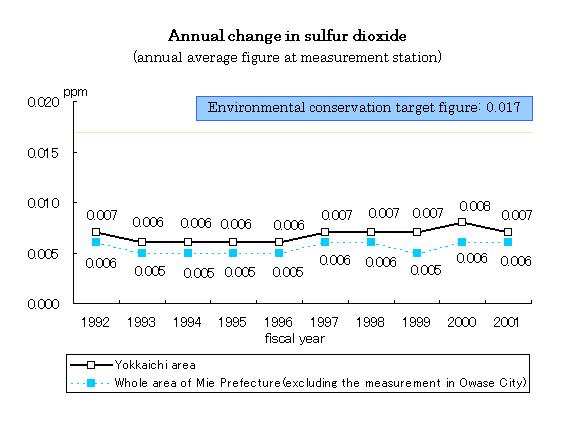
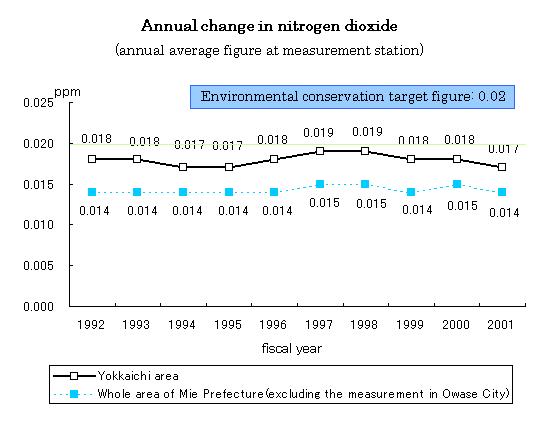
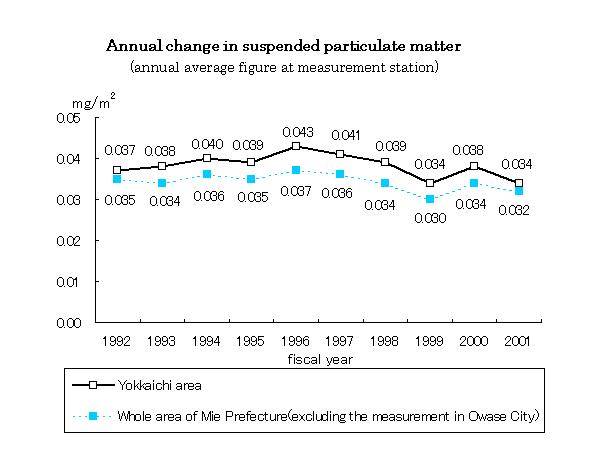
In order to take the initiative in efforts to reduce global warming, we adopted the Mie Global Warming Prevention Plan (Challenge 6), and we are promoting measures with the aim of reducing emissions of greenhouse gases from the level of 1990 by 6 % by 2010.
The emission of carbon dioxide in Mie Prefecture in 1998 was 1.057 in the ratio to 1990.
The change in carbon dioxide (CO2) emissions in Mie Prefecture (Unit: t-C)
| Sector | 1990 | 1995 | 1997 | 1998 | ||
|---|---|---|---|---|---|---|
| Amount of discharge |
Amount of discharge |
Amount of discharge |
Amount of discharge |
Compared to '90 |
Compared to '97 |
|
| Industrial | 4,197 | 4,471 | 4,501 | 3,989 | 0.950 | 0.886 |
| Transportation | 985 | 1,263 | 1,219 | 1,181 | 1.199 | 0.969 |
| Private sector (households) |
560 | 666 | 676 | 653 | 1.166 | 0.966 |
| Private sector (offices) |
273 | 439 | 463 | 457 | 1.674 | 0.987 |
| Others | 511 | 568 | 600 | 614 | 1.202 | 1.023 |
| Total | 6,525 | 7,407 | 7,459 | 6,894 | 1.057 | 0.924 |
3. Problems with Noise, Vibration and Offensive Odors
Noise, vibration and offensive odors are familiar forms of pollution we encounter in our daily lives. Sometimes they can have a very demoralizing influence on us, not only physiologically, but psychologically as well.
As the source of complaints of noise, factories and business sites are most prevalent, followed by noise generated in sales and construction operations.
Also, complaints about offensive odors related with service industries and family life are increasing.
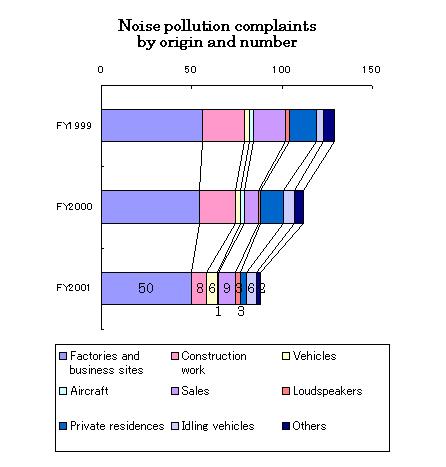
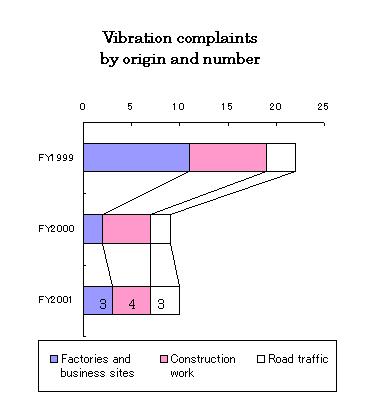
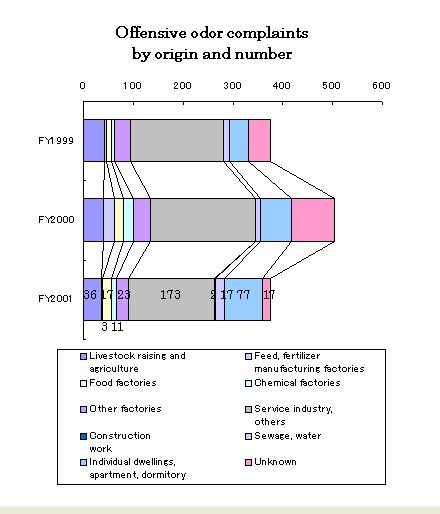
In order to prevent these problems, we are promoting on-site inspections of factories and manufacturing sites.
Offensive odor complaints by origin and number.
Those problems generated from family life are deeply concerned with individual private lives. So in addition to regulations by laws and ordinances, it is important for each person to notice and control them so that he or she does not cause trouble to the neighborhood.
4. Water Environment
In order to ensure continual monitoring of the extent of river and marine pollution, we have undertaken water quality monitoring at certain key points.
For water quality, the environment criteria is set for those concerning "the protection of human health" (health items) regarding such substances as cadmium and cyan. Also there are the environmental criteria for "living environment" (living environment items), which include biochemical oxygen demand (BOD) in rivers and chemical oxygen demand (COD) in the sea area.
Water observations in fiscal 2001 indicated that as to the health items, all the spots (65 spots in 45 river and 14 spots in 4 sea areas) cleared the environmental criteria.
On the other hand, as to the rate of achieving the environmental criteria of living environment items, BOD at rivers (60 spots in 59 water areas of 44 rivers) reached 71 %, while COD in sea areas (13 spots in 4 sea areas) stood at 63 % compared with 71 % and 50% in fiscal 2000 respectively. As for total nitrogen and total phosphorus, which are causative agents of eutrophication in the sea area, total nitrogen was 83% and total phosphorus recorded 100% in 6 water areas in 4 sea areas compared with 67 % and 83% in fiscal 2000 respectively.
Also, based on Mie Domestic Drainage Treatment Facilities Construction Plan (of the Domestic Drainage Treatment Action Program), Mie Prefecture is proceeding with the construction of facilities to treat daily life drainage such as sewers and septic tanks for amalgamation processing. In this plan, we aim at improving the rate of processing daily life drainage to around 70% by fiscal 2010. However, the rate of processing daily life drainage in Mie Prefecture at the end of fiscal 2001 was very low, at 57.2%.
As for dioxin, we conducted a survey of water quality at 52 spots of environmental criteria in Mie Prefecture (39 rivers and 13 sea areas) and found that the results were higher than environmental criteria at two spots. Regarding environmental hormones, we conducted a total of 13 substances including polychlorinated biphenyl at 40 spots of environmental criteria in the prefecture (27 rivers and 13 sea areas). As a result, we detected 6 substances in water quality, and 8 substances in deposit.
Results of the rate of processing daily life drainage (at the end of fiscal 2001)
| Area | Public sewerage |
Agricultural village drainage facilities |
Fishery village drainage facilities |
Community plant |
Septic tank for amalga- mation processing |
Total |
|---|---|---|---|---|---|---|
| Mie | 28.8% | 3.3% | 0.2% | 0.3% | 24.5% | 57.2% |
| Whole land area |
63.5% | 2.3% | 0.3% | 7.6% | 73.7% | |
Note) Rate of daily life drainage processing:
Population possible for processing / population based on basic resident register * 100 (%)
The processing rate in the whole country was calculated by Mie Prefecture based on the data made public.
The sum of processing rate does not correspond to the total of individual figures because they were rounded off.
5. Natural environment
Mie Prefecture is blessed with a natural environment diversified and beautiful such as calm Ise Bay, Kumano rough sea known for the rough waves of the Pacific, steep Mt. Suzuka, magnificent Mt. Daiko and various clear streams or community wood- lands.
As contact with rich natural environment endows people with easy feelings and comfort, we maintain and manage facilities at natural parks including Ise-Shima National Park by considering natural environment so that people can use them comfortably and safely. Those natural parks are in 9 designated places with the area totaling about 205,000 ha, sharing about 35.4 % of total prefectural land.
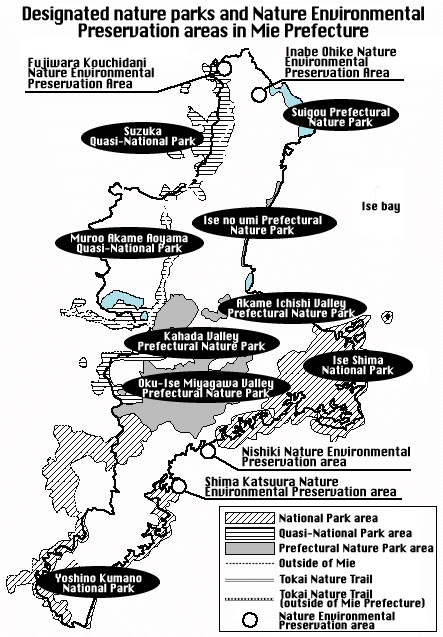
The Tokai Nature Trail links Meiji Forest in Tokyo (Takao Quasi-national Park) to Meiji Forest in Osaka (Minogashira Quasi-national Park). In Mie Prefecture, the trail is about 197 km long and extends over 15 municipalities.
Also, Kinki Nature Trail is the eighth longest long-distance natural trail in Japan that lies between Matsushima-cho, Tsuruga City, Fukui Prefecture and Tottori, Seidan Town, Hyogo Prefecture. It is about 606 km long and extends over 28 municipalities in Mie Prefecture.
We are also maintaining these trails and posting signs so that citizens can enjoy them with ease.
Although voluntary conservation activities of local residents and groups are important to conserve a diversified natural environment, there are cases whereby such activities do not make progress because of a lack of funds.
On this account, we cooperate with those local residents and groups and municipalities to support their local activities to preserve the natural environment in our hometown. We carried out supporting projects at six places (six towns) in fiscal 2001.
Places where regional supporting projects were held to conserve natural environment in hometowns (Fiscal 2001)
| Municipalities |
Names of activity groups |
The supporting projects carried out by municipalities |
|---|---|---|
| Komono Town | Group to conserve natural environment in Nishikomono | The reconstruction of plant vegetation peculiar to the region, setting up of billboards |
| Tado Town | Local residents | Leak-prevention and maintenance of irrigation canal flowing into habitation reservoirs |
| Ureshino Town | Ukisato village revitalization conference | security of habitats for red spotted masu trout and sweetfish |
| Iitaka Town | Miyamae tree-raising group | Thinning, planting of broadleaf trees |
| Hamajima Town | Nanbari regional group | The establishment of billboards for conservation of natural environment (Mt. Obabeta) |
| Iga Town | Local residents | Planting of broadleaf trees |
6. Forest Preservation
The forests in Mie Prefecture amounted to 375,663ha at the end of fiscal 2001, sharing about two-thirds of the prefectural land area. Among them, national forests occupy 6.4%, while the ratio of forests under private ownership are the remaining 93.6%. In addition, we designated as reserved forests a total of 105,557ha that equals to 28.1% of forest area in the prefecture (18.3% of prefectural land) to conserve and manage them as forests that have a function of the public interest. We newly designated 1,581 ha in fiscal 2001 based on a plan to maintain reserved forests.
The role and kind of reserved forest
| Main role | Kind |
|---|---|
| Reserved forest to preserve high quality water | Reserved forest to recharge the source of rivers, reserved forest to prevent drought disaster |
| Reserved forest to prevent landslides and earth and rock avalanches | Reserved forest to prevent the outflow of earth and sand, reserved forest to prevent the collapse of earth and sand |
| Reserved forest to prevent other disasters | Reserved forest to prevent storm, reserved forest to prevent tide-water damage, reserved forest to prevent falling rock |
| Reserved forest to provide easy feelings and comfort | Reserved forest for health, reserved forest for natural beauty |
| Reserved forest to help the habitation and breeding of fish | Reserved forest with fish |
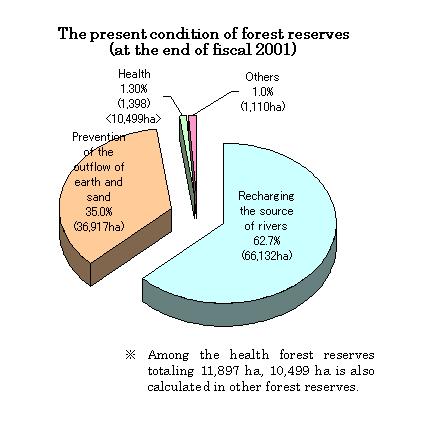
Forests work by recharging the source of rivers and preventing global warming by absorbing carbon dioxide. Also, they are places where wild creatures such as birds or animals live, and we humans can rest and become relaxed.
We are proceeding with the maintenance of forests so that people can feel familiar with forests and obtain their blessing.
Also, we are promoting a movement to maintain forests with voluntary participation of people in the prefecture by locating individuals who are potentially seeking to work as forest volunteers, and giving them training guidance, and offering them information about the fields and funds for activities.
Situation of holding local training and conference
|
Date |
Location |
Contents |
|---|---|---|
|
Nov. 17, 2001 |
Komono Town |
Green volunteer training meeting (Hokuse district) |
|
Jan. 27, 2002 |
Miyagawa Village |
Green volunteer training meeting (Naka-nanse district) |
|
Feb. 3, 2002 |
Ueno City |
Green volunteer training meeting (Iga district) |
|
Dec. 8, 2001 |
Kumano City |
Green volunteer training meeting (Owase, Kumano districts) |
|
Nov. 3-4, 2001 |
Omiya Town |
Green volunteer leader training meeting |
7. Environmental education and study
Mie prefectural Environmental Education Information Center is making efforts to become a facility that people, from children to adults, can use as a foothold for environmental education, study and information dispatch. The center offers the website "the Environment in Mie", develops teaching materials and conducts research for environmental education, as well as providing displaying and library function.
At schools in the prefecture, students are learning the importance of the natural environment through study of familiar local environmental problems and various experiences in rich natural environment. Also we are promoting students' participation in volunteer work about environmental conservation.
In order to develop high consciousness toward environmental conservation of children responsible for the next generation, we formed an eco-club for children. This club is for working on environmental study and recycling activities. For promotion of these activities, we hold meetings for exchange for members and supporters of each club, and hold meetings to train supporters and municipal officials in charge of who support those activities. In fiscal 2001, the membership reached 7,237 people of 303 groups so that the membership and the rate of admission became the number one in Japan.
Situation of environmental education and study (fiscal 2001)
|
Division |
Division Contents |
|---|---|
|
Holding of participation-type courses to study the environment |
More than 40 courses were held including "atmospheric research network course " and "clues to identify wild birds." |
|
Development and offering of teaching materials |
Panels for understanding the environment were made, while leasing kits for environmental study |
|
Training of leaders for environmental education |
For training leaders for environmental education, courses such as "course to train general leaders" based on "project-wild" (the method used in the U.S. for guiding environmental education, "course to train interpreters" and "environmental study seminar in Mie" were held. |
|
Others |
We leased enlightening panels and the samples of eco-mark products for environmental fairs held by municipalities and participated in the fairs. |
Results of holding meetings for exchange and training
| Division | Date | Contents |
|---|---|---|
| Children eco-club exchange meeting within Mie Prefecture (Mie children eco-kingdom meeting) | August 26, 2001 |
Environment experiencing study, 284 participants |
| Children eco-club exchange meeting in Mie Prefecture in Hisai | November 25, 2001 |
Environment experiencing study and announcement of activities (held in Hisai City), 450 participants |
| Environment bus school (experience of natural environment in Yokoyama) | January 26, 2002 |
Ise-Shima National Park, Yokoyama, 21 participants |
| Children eco-club meeting for training leaders | February 24, 2002 |
Training of supporters and leaders, 24 participants |
